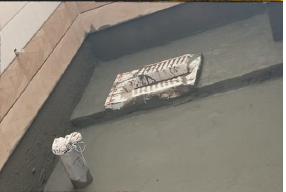Services
Our Roofing Services
Ground Floor Protection
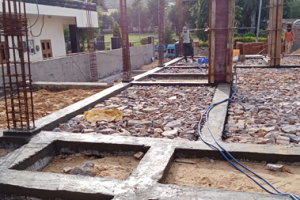
At Eeco India we understand that the ground floor is particularly vulnerable to water damage, making it crucial to fortify against moisture infiltration.
Core Cutting/Hole Packing
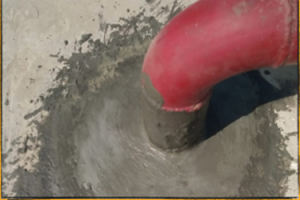
At EECO, we understand that precise and effective core cutting and hole packing are essential for achieving a watertight seal in your property.
Flooring Plinth Protection
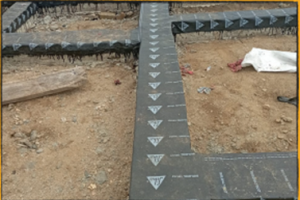
These integral components of waterproofing form the first line of defense against moisture infiltration, ensuring the structural integrity
Basement Waterproofing
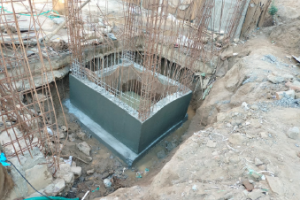
Elevate your property’s protection with our basement waterproofing service. At EECO, we specialize in creating impenetrable barriers
Washing Area Water Tank
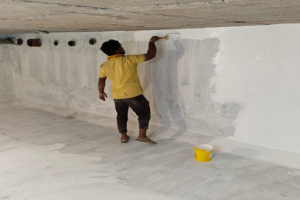
These areas are prone to frequent water exposure, making them vulnerable to damage.Our waterproofing services
offer a reliable shield against rain, wind, and moisture. A reliable water tank is essential for a consistent water supply, but leaks and cracks can compromise its functionality. Our water tank waterproofing services ensure that your water storage remains secure and contamination-free.
Roof Waterproofing
Terraces are exposed to harsh weather conditions and are highly susceptible to water infiltration. Our terrace waterproofing services are designed to create a robust and long-lasting barrier against moisture, protecting your property from leaks, cracks, and structural damage against moisture, safeguarding your basement from potential leaks and flooding. Trust us to keep your lower level dry, secure, and free from water-related challenges.
Metal roofs offer durability and longevity, but they require specialized waterproofing to prevent rust, corrosion, and water seepage. Our metal roof waterproofing solutions are tailored to your specific roofing materials, ensuring they remain watertight and functional for years to come against moisture, safeguarding your basement from potential leaks and flooding.
Expert Crack Repair
And Waterproofing Services For Your Home
Cracks in your kitchen can be unsightly and potentially lead to water damage. Our skilled technicians specialize in repairing kitchen cracks, ensuring not only a seamless appearance but also a waterproof and durable solution. Trust us to make your kitchen look as good as new.
Marble joints are prone to cracks and can be a source of water leakage. Our experts have the knowledge and tools to repair these joints effectively. We use premium marble fillers and sealers to restore the beauty and functionality of your marble surfaces while preventing future leaks
Leaky tile joints can lead to water damage and mold growth. Our tile joint repair service includes meticulous grout removal and replacement with high-quality, water-resistant grout. We leave your tiled surfaces looking pristine and safeguarded against moisture infiltration.
RCC structures with cracks can compromise the integrity of your home. Our RCC crack repair service involves the thorough cleaning and sealing of cracks with top-grade epoxy or concrete fillers. Rest easy knowing your home’s structural stability is in expert hands.
Specialized Waterproofing Services
Tin sheds are commonly used in various structures, and their joints can be prone to leaks over time.Our tin shed joint waterproofing service involves applying specialized sealants and coatings to ensure a watertight and weather-resistant seal. Protect your valuable assets from water damage with our reliable solutions
Construction joints are crucial for structural integrity, but they are also susceptible to water penetration. Our construction joint waterproofing service utilizes advanced materials and techniques to seal and reinforce these joints effectively. We help extend the lifespan of your building while preventing water-related issues.
Expansion joints allow for the natural movement of structures, but they can become pathways for water infiltration if not properly maintained. Our experts specialize in expansion joint waterproofing, using flexible and durable materials to create a robust barrier against moisture. Ensure the longevity of your building’s expansion joints with our professional solutions.
Flooring System
Composition
Epoxy flooring is made from a two-part resin system – epoxy resin and a hardener. When mixed, they chemically react to form a durable and rigid surface.
Durability
Epoxy floors are exceptionally durable and can withstand heavy foot traffic and machinery. They are highly resistant to abrasion, chemicals, and impact.
Appearence
Epoxy floors are available in a wide range of colors and can be customized with various patterns, flakes, and textures. They create a glossy, seamless surface.
Maintenance
Epoxy floors are easy to clean and maintain, making them suitable for areas like garages, warehouses, and laboratorie
Installation
Installation typically requires proper surface preparation, including cleaning and leveling. It may involve multiple layers and can take several days to cure fully.
Deconstruction
There has been considerable interest in the benefits of designing for deconstruction . The ability to dismantle a building and use the components .
Construction Joint
In rebarring, a construction joint may refer to a deliberate break or interface created in a concrete structure where one portion of the concrete is poured or placed at a different time from another. This is often done for practical reasons, such as when a large concrete pour needs to be completed in sections or over multiple days.
A construction joint in rebarring is relevant because it can impact the placement of reinforcing bars (rebars). The rebars in one section may need to be carefully aligned and terminated to allow for the continuation of reinforcement in the next section of the pour. These joints are designed to maintain structural integrity and load transfer across the interface, and rebarring work must be coordinated accordingly.
In fastener anchoring, a construction joint may refer to a specific location in a structure where fasteners or anchors are installed to secure objects or components to a base material, such as concrete or masonry. These joints can exist in various forms:
- Control Joints: Control joints are created intentionally in concrete floors, walls, or slabs to control cracking and allow for movement due to temperature changes and settling. Fasteners or anchors installed near these control joints must be designed to accommodate the anticipated movement.
- Expansion Joints: Expansion joints are used to accommodate significant structural movement, such as that caused by temperature fluctuations, seismic activity, or other factors. Fasteners installed near expansion joints must be carefully designed to allow for the movement of the connected components.
Column Repair in Rebaring
Column repair in the context of rebarring involves the restoration and strengthening of vertical structural elements known as columns or pillars. Columns play a crucial role in supporting the weight and load-bearing capacity of a building or structure. Over time, columns can deteriorate due to various factors, such as corrosion, structural damage, or inadequate reinforcement.
- Assessment: The first step in column repair is a thorough assessment to evaluate the extent and causes of damage or deterioration. This may involve visual inspections, non-destructive testing, and structural analysis.
- Rebar Installation: If the existing columns lack sufficient reinforcement or have experienced corrosion, additional reinforcing bars (rebars) are installed within the column. The rebars are carefully placed and anchored to provide structural strength and prevent further degradation.
- Concrete Repair: The concrete surrounding the column may require repair, which can include the removal of deteriorated material, surface preparation, and the application of new concrete or repair mortar to restore the column’s surface and strength.
- Corrosion Protection: Measures to prevent future corrosion, such as coatings or protective wraps on the rebars, may be applied to enhance the durability of the repaired column.
- Quality Control: Quality control measures are crucial to ensure that the column repair work meets engineering standards and safety requirements. Proper curing and testing may be performed to verify the integrity of the repair.
Column repair related to fastener anchoring typically involves addressing issues with the anchoring of fixtures or components to the column. This can include situations where fasteners have become loose, corroded, or damaged, compromising the stability of the attached elements.
Common steps in column repair with fastener anchoring may include:
- Fastener Replacement: If fasteners used to secure objects to the column have failed or deteriorated, they are removed and replaced with new, properly sized and rated fasteners.
- Anchor Point Inspection: The condition of the anchor points on the column is assessed to ensure they are structurally sound and suitable for anchoring.
- Reattachment of Components: Once the fasteners and anchor points are addressed, components or fixtures are reattached securely to the column using appropriate anchoring methods.
CC Road Repair in Rebarring: When it comes to concrete (CC) road repair using rebarring, the focus is typically on reinforcing and restoring damaged or deteriorating concrete road surfaces. This can involve adding reinforcing bars (rebars) to strengthen weakened areas, repairing cracks, and addressing surface wear to extend the life of the road. The rebarring process in this context helps improve the structural integrity and durability of the road, ensuring it can withstand traffic loads and environmental factors
In fastener anchoring for CC road repair, the emphasis is on securing objects or fixtures to the concrete road surface. This might include installing fasteners or anchors to affix road signs, guardrails, or other components in place. These anchors are crucial for maintaining the stability and safety of road infrastructure, ensuring that attached elements remain securely anchored to the CC road surface, even in the face of heavy traffic and adverse weather conditions
Polyurethane (PU) Flooring
Maintenance
PU floors are also easy to clean and maintain. They are often used in settings like sports floors, healthcare facilities, and retail spaces.
Installation
PU flooring installation is similar to epoxy but may require a slightly different application process. It can be quicker to install and cure.
Composition
Polyurethane flooring consists of a polyurethane resin, which can be either water-based or solvent-based. It forms a flexible and elastomeric surface.
Appearance
PU floors have a matte or satin finish and are available in various colors. They provide a more natural look compared to the high-gloss finish of epoxy.
Durability
PU floors offer good durability and are known for their flexibility. They can withstand moderate to heavy foot traffic and are resistant to chemicals, UV radiation, and temperature variations.
Deconstruction
There has been considerable interest in the benefits of designing for deconstruction . The ability to dismantle a building and use the components .
Flooring
In the context of rebarring and fastener anchoring, “flooring” typically refers to the surface or flooring material that is installed over or around the rebars and fasteners. It is not directly related to the rebarring or fastener anchoring processes themselves but rather to the finished surface that is applied on top of the structural elements.
Flooring in Rebarring
When rebarring is performed in a construction or renovation project, it is often done to reinforce and strengthen the underlying concrete structure, such as a floor or slab. Once the rebarring work is completed, a flooring material is applied over the reinforced concrete surface to create a finished floor. Common flooring options includes :-
Ceramic or porcelain tiles are a popular choice for their durability and aesthetics. They can be installed directly over the reinforced concrete.
In some cases, hardwood planks or engineered wood can be used as the finished flooring material, especially in residential settings.
Carpeting is another option for covering reinforced concrete floors, providing comfort and sound insulation.
Epoxy coatings are often applied directly over reinforced concrete surfaces to create a seamless, durable, and chemical-resistant flooring system, commonly used in industrial and commercial settings.
Flooring in Fastener Anchoring
In fastener anchoring, the flooring aspect is related to the finished surface over which the fasteners are installed or anchored. Fasteners are used to secure various elements, such as fixtures, equipment, or structural components, to a base material, which can include concrete floors, walls, or ceilings. The flooring material can vary widely and depends on the specific application:-
Fastener anchoring is commonly used in securing fixtures to concrete floors, such as in commercial and industrial settings. The concrete floor itself serves as the flooring material.
In some cases, fastener anchoring may be used in wooden floors to secure items like baseboards, shelving, or cabinetry.
Fastener anchoring can also be employed in securing items to ceilings and walls, where the finished surface may include drywall, plaster, paneling, or other materials.
Floor Repair
Floor repair” in the context of rebarring and fastener anchoring refers to the process of addressing and rectifying issues or damage to the flooring or base material where rebarring or fastener anchoring has been or will be performed. These repairs are necessary to ensure the stability, safety, and longevity of the flooring or base material
Floor Repair in Rebarring:-
One common issue that may necessitate floor repair in rebarring is the presence of cracks in the concrete floor or slab. These cracks can occur due to various factors, including structural settlement, temperature fluctuations, or insufficient reinforcement. Floor repair may involve filling and sealing these cracks to prevent further damage and ensure a smooth, even surface.
Before rebarring is carried out, the existing floor surface may need to be prepared through processes such as cleaning, leveling, or removing deteriorated sections
Membranes
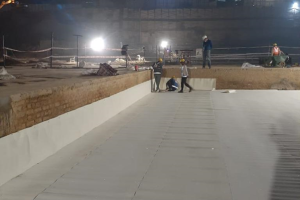
HDPE Membrane
A High-Density Polyethylene (HDPE) membrane is a robust and versatile material used in construction and environmental applications. Composed of a thermoplastic polymer, HDPE boasts exceptional durability, flexibility, and impermeability.
It is employed as a waterproofing solution for basements, roofs, and tunnels, creating a seamless barrier against water intrusion. In environmental protection, HDPE geomembranes line landfills, ponds, and hazardous waste sites, preventing contamination of soil and groundwater. Additionally, it plays a crucial role in infrastructure projects, safeguarding pipelines and structures from corrosion and root intrusion. HDPE membranes offer long-lasting protection, contributing to the durability and sustainability of various applications.

EPDM Membrane
Ethylene Propylene Diene Monomer (EPDM) membrane is a synthetic rubber roofing and waterproofing material renowned for its exceptional durability, versatility, and weather resistance. It is commonly used in commercial and residential roofing applications
as well as for waterproofing projects. EPDM membranes consist of a high-quality synthetic rubber compound that exhibits remarkable resistance to ultraviolet (UV) radiation, temperature fluctuations, ozone exposure, and other environmental factors. These membranes are available in various thicknesses and can be mechanically attached, adhered, or ballasted during installation. EPDM roofing systems offer long-term protection, energy efficiency, and easy maintenance, making them a popular choice for flat and low-slope roofs in construction projects.
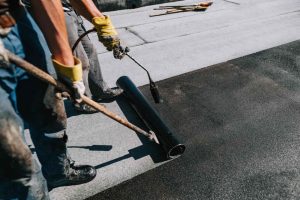
SBS Membrane
Styrene-Butadiene-Styrene (SBS) membrane is a type of modified bitumen roofing material widely used in commercial and residential construction. It combines bitumen, a viscous hydrocarbon, with SBS rubber polymers to enhance its performance.
SBS membranes offer excellent flexibility and elongation properties, making them highly resistant to cracking and extreme temperature variations. They are known for their durability, weather resistance, and waterproofing capabilities. SBS roofing membranes are commonly applied as multi-layer systems and can be torch-applied, self-adhered, or hot-mopped during installation. They provide reliable protection against water infiltration and are commonly used for low-slope and flat roofs, ensuring long-lasting and weather-resistant roofing solutions
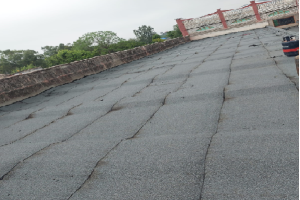
APP Membrane
APP (Atactic Polypropylene) membrane is a type of modified bitumen roofing material widely used in the construction industry for its durability and waterproofing properties. It is created by modifying bitumen with APP polymers, enhancing its resistance to heat, UV rays, and weathering.
APP membranes are known for their excellent flexibility, making them suitable for a variety of roofing applications. They are available in both torch-applied and self-adhering forms, making installation efficient. APP roofing systems provide a reliable and durable barrier against water infiltration, making them a popular choice for flat and low-slope roofs in commercial and residential buildings, ensuring long-lasting protection and weather resistance.
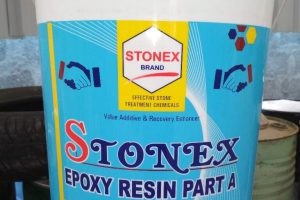
Stone Treatment Chemical
Stone treatment chemicals encompass a variety of products used for cleaning, protecting, and enhancing natural and engineered stone surfaces. These chemicals include stone cleaners to remove stains and dirt, stone sealers for moisture protection
and stone enhancers to enrich color. Polishing and conditioning products restore shine and smoothness. Stain removers target specific stains, and adhesives repair chipped stones. Color-enhancing sealers intensify natural stone colors, while anti-slip treatments enhance safety. Restoration chemicals rejuvenate older stones, and preservation products strengthen historic structures. Proper selection and application of these chemicals are crucial for maintaining the appearance, durability, and safety of stone surfaces.
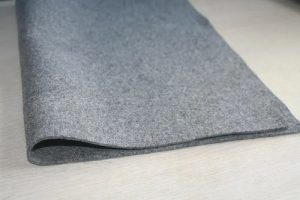
Geo Textile Cloth
Geotextile cloth is a versatile synthetic fabric used in civil engineering and construction. It serves as a critical component in various geotechnical and environmental applications. Geotextiles are designed to enhance soil stability, drainage, erosion control
and separation of different soil layers. These fabrics can be woven or non-woven and are characterized by their high tensile strength, durability, and permeability. Geotextile cloth is commonly used for reinforcing retaining walls, roadways, and embankments. It also plays a crucial role in filtering and preventing soil erosion in drainage systems, landfills, and erosion control applications, contributing to improved infrastructure and environmental protection.
Bridge Repair in Rebarring
Bridge repair involving rebaring primarily focuses on the structural rehabilitation of bridge components, especially those made of reinforced concrete. Rebaring techniques may be applied to address several issues:
Bridges are often exposed to harsh environmental conditions, leading to corrosion of the reinforcing bars (rebars) within the concrete. Rebarring involves the replacement or addition of rebars to strengthen and protect the bridge against further corrosion
Older bridges may require structural improvements to handle increased loads or to meet modern safety standards. Rebarring can be employed to reinforce and strengthen critical bridge elements, such as girders, piers, or abutments
Cracks in bridge components can compromise their structural integrity. Rebarring may be used to address these cracks, restoring the structural soundness of the bridge
In some cases, the concrete surfaces of the bridge may deteriorate over time due to wear, weathering, or chemical exposure. Rebarring can involve concrete repair or replacement to ensure the bridge’s longevity
Fastener anchoring is used to attach guardrails, traffic signs, and other safety features to the bridge. Proper anchoring is essential to maintain safety on the roadway
Expansion joints are critical for accommodating bridge movement due to temperature changes and structural settling. Fastener anchoring may be involved in maintaining or replacing these joints to prevent water ingress and deterioration
The bridge deck, the top surface of the bridge, may require fastener anchoring for repairs or the installation of additional features, such as expansion joint systems or drainage systems
Epoxy/PU Grouting System
Epoxy and polyurethane (PU) grouting systems are used in construction and engineering for various purposes, primarily to fill voids, repair concrete structures, and provide additional support. Here’s an overview of these two grouting systems:
Epoxy Grouting System
Epoxy Resin
Epoxy grouting uses epoxy resin as the base material. Epoxy is a thermosetting polymer that, when mixed with a hardener, forms a strong, durable, and chemically resistant material.
Applications
Epoxy grouting is commonly used in applications where high strength, chemical resistance, and minimal shrinkage are essential. It’s often employed for anchoring bolts, repairing cracks in concrete, underpinning foundations, and bonding various construction materials.
Properties
Epoxy grout provides exceptional compressive and tensile strength, making it suitable for heavy-duty applications.
Epoxy is resistant to a wide range of chemicals and is often used in environments with exposure to corrosive substances.
Epoxy grout has minimal shrinkage during curing, which helps maintain the integrity of the grouted area
Epoxy bonds well to various substrates, creating a strong and reliable connection.
Epoxy grouting is commonly found in industrial settings, such as manufacturing facilities, chemical plants, and infrastructure projects, where structural stability and chemical resistance are critical
Polyurethane (PU) Grouting System
Polyurethane Resin
PU grouting uses polyurethane resin as the primary material. Polyurethane is a versatile polymer that can be formulated to exhibit various properties.
Applications
PU grouting is often used for filling voids, stabilizing soil, and mitigating water infiltration. It’s commonly employed in foundation repair, soil stabilization, and concrete lifting applications
Properties
PU grout is lightweight and can be injected into small cracks or voids with minimal disruption to surrounding structures.
PU grout expands as it cures, which can help lift and level settled concrete slabs or foundations
PU grout is water-resistant and is often used to seal leaks in basements, tunnels, and dams
PU grout typically cures quickly, allowing for rapid project completion
PU grouting is commonly used in residential, commercial, and civil engineering applications. It is particularly useful for foundation repair, underpinning, and soil stabilization

